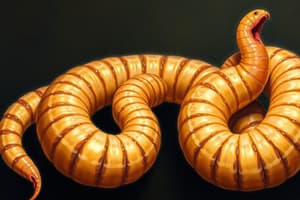Podcast
Questions and Answers
What is the primary mode of transmission for parasitic worms?
What is the primary mode of transmission for parasitic worms?
- Through contaminated food, water, or soil (correct)
- Through vectors like mosquitoes
- Through direct human contact
- Through airborne particles
What is the classification of liver or lung flukes?
What is the classification of liver or lung flukes?
- Nematodes
- Platyhelminthes
- Cestodes
- Trematodes (correct)
Which of the following is NOT a type of Nematode?
Which of the following is NOT a type of Nematode?
- Ascaris lumbricoides
- Tapeworm (correct)
- Trichuris trichiura
- Enterobius vermicularis
Where do Cestodes typically live in the human body?
Where do Cestodes typically live in the human body?
What is another name for Necator americanus?
What is another name for Necator americanus?
What is a common route of transmission for parasitic worms?
What is a common route of transmission for parasitic worms?
What type of parasitic worm is Trichuris trichiura?
What type of parasitic worm is Trichuris trichiura?
Where do tapeworms typically live in the human body?
Where do tapeworms typically live in the human body?
What is another name for Enterobius vermicularis?
What is another name for Enterobius vermicularis?
Which of the following is a type of Trematode?
Which of the following is a type of Trematode?
Flashcards are hidden until you start studying
Study Notes
Parasitic Worms (Helminths)
- Common routes of transmission include contaminated food, water, or soil.
Classification of Helminths
- Platyhelminthes (Flatworms) include two subclasses: Trematodes and Cestodes.
- Trematodes: Flukes, such as liver or lung flukes.
- Cestodes: Tapeworms, living in the intestines.
Nematodes (Roundworms)
- Include Ascaris lumbricoides, a type of roundworm.
- Trichuris trichiura, a type of whipworm, is also a Nematode.
- Enterobius vermicularis, also known as pinworm, is a type of Nematode.
- Necator americanus, also known as hookworm, is a type of Nematode.
Parasitic Worms (Helminths)
- Common routes of transmission include contaminated food, water, or soil.
Classification of Helminths
- Platyhelminthes (Flatworms) include two subclasses: Trematodes and Cestodes.
- Trematodes: Flukes, such as liver or lung flukes.
- Cestodes: Tapeworms, living in the intestines.
Nematodes (Roundworms)
- Include Ascaris lumbricoides, a type of roundworm.
- Trichuris trichiura, a type of whipworm, is also a Nematode.
- Enterobius vermicularis, also known as pinworm, is a type of Nematode.
- Necator americanus, also known as hookworm, is a type of Nematode.
Studying That Suits You
Use AI to generate personalized quizzes and flashcards to suit your learning preferences.




